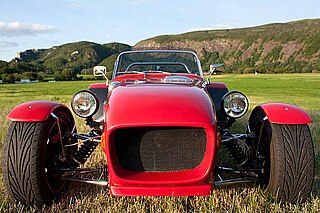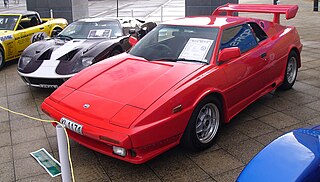
The Ford GT40 is a high-performance endurance racing car with the Mk I, Mk II, and Mk III model cars being based upon the British Lola Mk6, and were designed and built in England, while the GT40 Mk IV model was designed and built in the United States. The range was powered by a series of American-designed and built engines modified for racing. The GT40 won the 24 Hours of Le Mans four consecutive times, from 1966 to 1969, including a 1-2-3 finish in 1966. In 1966, with Henry Ford II personally in attendance at Le Mans, the Mk II GT40 provided Ford with the first overall Le Mans victory for an American manufacturer, and the first victory for an American manufacturer at a major European race since Jimmy Murphy's triumph with Duesenberg at the 1921 French Grand Prix. The Mk IV GT40 that won Le Mans in 1967 is the only car designed and built entirely in the United States to achieve the overall win at Le Mans.

A Locost is a home-built car. The car features a space frame chassis usually welded together from mild steel 1 in × 1 in square tubing. Front suspension is usually double wishbone with coil spring struts. The rear is traditionally live axle, but has many variants including independent rear suspension or De Dion tube. Body panels are usually fiberglass nose and wings and aluminium side panels. Each car is highly individualized according to the resources, needs and desires of each respective builder.

The MacPherson strut is a type of automotive suspension system that uses the top of a telescopic damper as the upper steering pivot. It is widely used in the front suspension of modern vehicles and is named for American automotive engineer Earle S. MacPherson, who invented and developed the design.

The Mazda RX-8 is a sports car manufactured by Japanese automobile manufacturer Mazda between 2002 and 2012. It was first shown in 2001 at the North American International Auto Show. It is the successor to the RX-7 and, like its predecessors in the RX range, it is powered by a rotary Wankel engine. The RX-8 was available for sale in North America from the 2003 model year.

Steering is the collection of components, linkages, etc. which allows any vehicle to follow the desired course. An exception is the case of rail transport by which rail tracks combined together with railroad switches provide the steering function. The primary purpose of the steering system is to allow the driver to guide the vehicle.

Lotus Elan is the name of two separate ranges of automobiles produced by Lotus Cars.

In automobiles, a double wishbone suspension is an independent suspension design using two wishbone-shaped arms to locate the wheel. Each wishbone or arm has two mounting points to the chassis and one joint at the knuckle. The shock absorber and coil spring mount to the wishbones to control vertical movement. Double wishbone designs allow the engineer to carefully control the motion of the wheel throughout suspension travel, controlling such parameters as camber angle, caster angle, toe pattern, roll center height, scrub radius, scuff and more.

The Chapman strut is a design of independent rear suspension used for light cars, particularly sports and racing cars. It takes its name from, and is best known for its use by, Colin Chapman of Lotus.
Sylva Autokits is a kit car manufacturer based in Lincolnshire, England. Sylva was founded in 1981 by Jeremy Phillips and has developed and produced a number of small and lightweight sports cars. Sylva cars have won a number of 750 Motor Club Kit Car championships.
Automotive suspension design is an aspect of automotive engineering, concerned with designing the suspension for cars and trucks. Suspension design for other vehicles is similar, though the process may not be as well established.
The Blakely Bantam was a kit car produced by Blakely Auto Works, a manufacturer of kit cars located in a series of US midwest communities in the 1970s and 1980s. Blakely Auto was founded by Dick Blakely to market affordable sports cars in the spirit of the legendary Lotus Seven: compact, lightweight, and with excellent handling. The Bantam's design inspiration was the Dutton, a Lotus Seven replica built in Britain. The Bantam was introduced in 1972 as Blakely's first offering, followed by the larger Bearcat and eventually by the Bernardi. Production of the Bantam continued into the 1980s, when the model was renamed the Hawk, and stopped with the dissolution of Bernardi Auto Works in the later 1980s.

The Hornet is a Lotus Seven copy created as a kit car by T&J Sportscars to use components from the Ford Cortina Mk3 and later Mk4 or Mk5. This allowed a choice of 1300/1600 OHV pushrod Ford Kent engines or 1600/2000 single overhead camshaft Ford Pinto engines. All the running gear is sourced from the Cortina, although T&J-manufactured front wishbones were an option to replace the Cortina pressed-steel items. Parts needing modification are the propshaft, which needs to be shortened, and the alternator that needs to be repositioned.

The Sylva Striker is the most enduring of the Sylva models and was a radical evolution of the Star and Leader, dropping the Viva donor car in favour of purpose-built suspension and lighter bodywork. The car was aimed at two markets, the home car builder that required an economical kit that could be built using readily available mechanics tools and the more demanding race car builder who favoured good handling and simple design.

Haynes Roadster is a replica of Lotus Seven home-built according to a book Build Your Own Sports Car: On a Budget by Chris Gibbs (ISBN 1-84425-391-0). Ford Sierra is used in the car as a donor for drivetrain and suspension components.
Mills Extreme Vehicles (MEV) is a kit car design and manufacturing company based in Mansfield, Nottinghamshire, England, founded in 2003. As of January, 2016 they manufacture the Exocet, an exoskeletal design and the Replicar, a full-body design inspired by the 1950s Aston Martin DBR1. Both cars use donor parts from the Mazda MX5 Mk1 sports car. An enhanced version of the Exocet, the MX150R, can participate in UK race series regulated by the 750 Motor Club and the MSA.

The Dax Rush is a lightweight two-seater sports car. It is offered as a kit, and is a popular choice among Kit Car builders. It has a multi-tube triangulated steel space frame chassis, front engine and rear wheel or four wheel drive. The body is constructed in Glass-Reinforced Polymer (GRP) with optional aluminium side panels and bonnet. It complies with the Single Vehicle Approval (SVA) scheme. Two optional rear suspension technologies are offered; De Dion and the IRS. The car is known for its 0–100 km/h performance of close to 3 second runs.

Heron Cars were racing cars, sports and kit cars built in New Zealand between 1962 and 1999 by Ross Baker. They also included a one-off electric car.
Crawford Composites is an American manufacturer of carbon fiber and composite parts company based in Denver, North Carolina. Crawford designs and manufacture structural and non-structural composite components in industries such as aerospace, aviation, motor sports, health care, defense and structural construction.
The Audi R8 LMS Cup is a one-make sports car racing series by Audi based in Asia. Audi R8 LMS Cup cars based on the Audi R8 LMS(GT3).

New Zealand had a long history of small garages and vehicle enthusiasts modifying and creating sports and sports racing cars. Out of these interests grew the New Zealand kit and replica car industry with the introduction of fibre-glass car bodies in the 1950s.

















